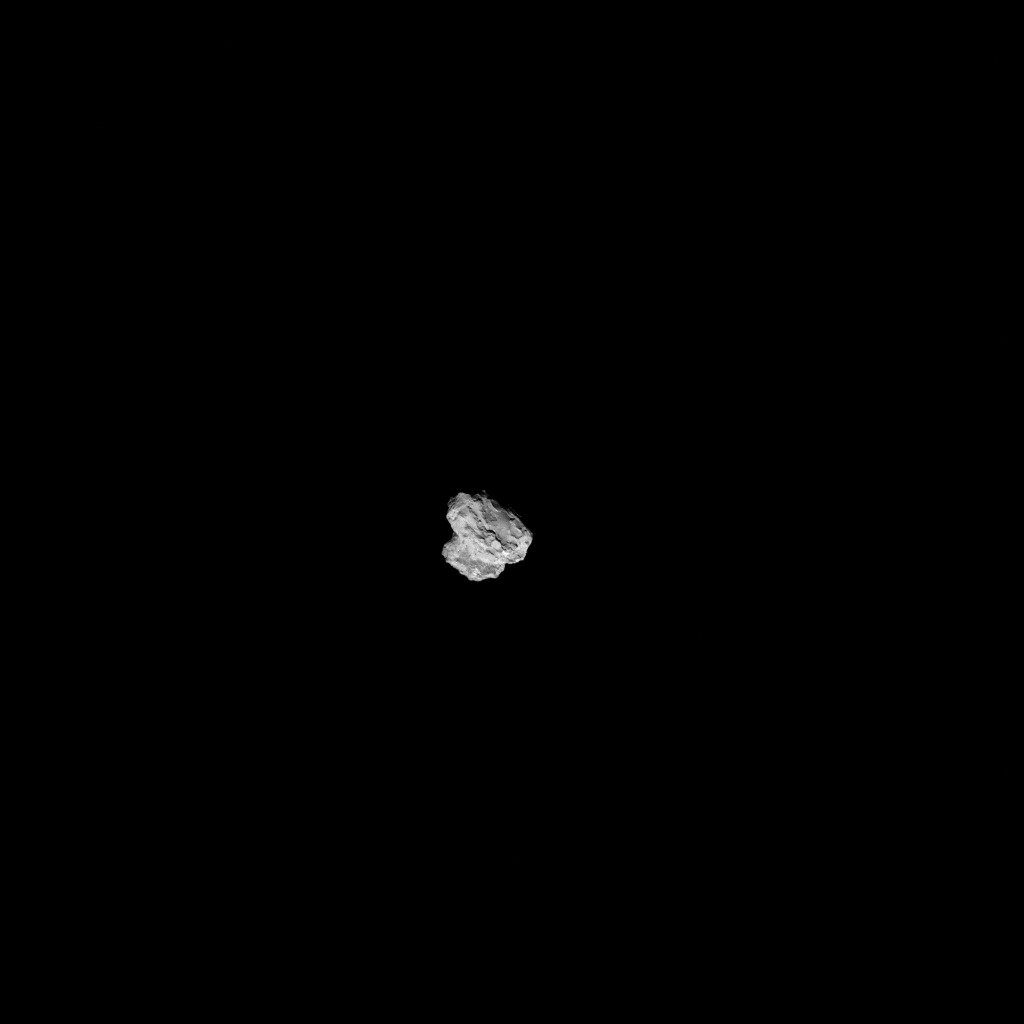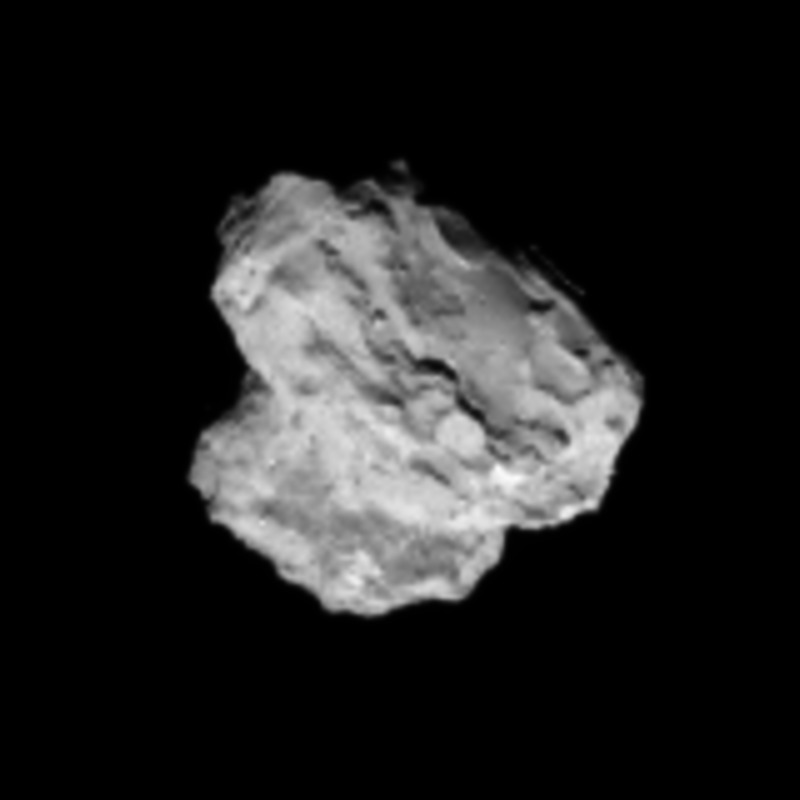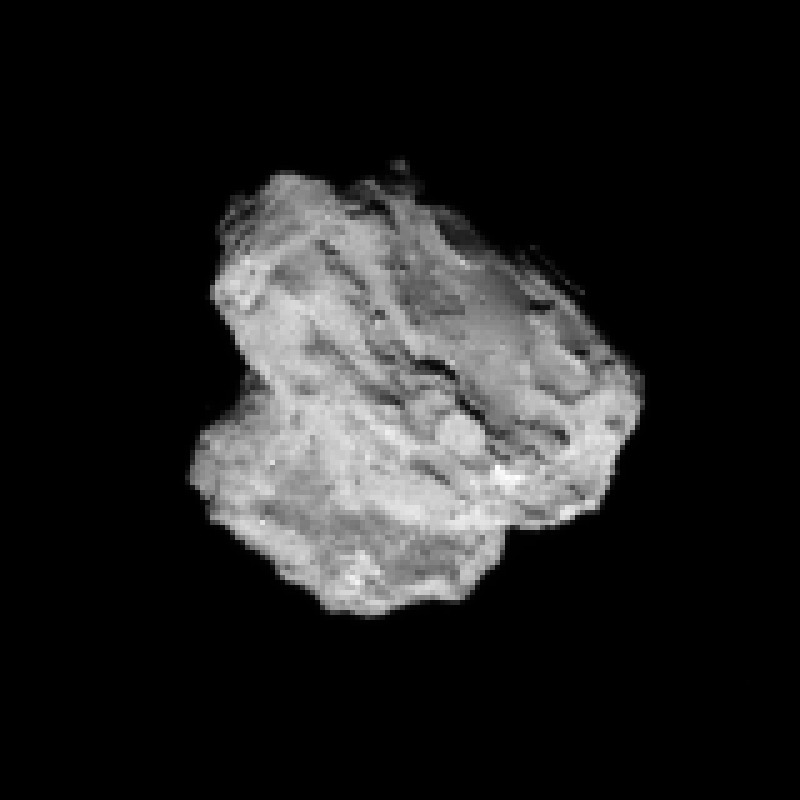Rosetta navigation camera (NAVCAM) image taken on 2 August 2014.
While the full frame version remains at 1024 x 1024 pixels, the window size for the interpolated version has been reduced to 160 x 160 pixels to fit the growing nucleus in. Consequently, the factor for scaling up and interpolation has been reduced to 5 (originally 10). The most prominent “pixel pair artefacts” observed in previous images have been cleaned.
We also show today for comparison both the crop of the interpolated and non-interpolated versions.

Full-frame NAVCAM image taken on 2 August 2014 from a distance of about 500 km from comet 67P/Churyumov-Gerasimenko. Credits: ESA/Rosetta/NAVCAM











Discussion: 29 comments
Something soooo far away….thanks Rosetta for giving us a glimps of the eternity….thansk guys:)
It looks like the artefact that was spotted on the CCD sensor from the AUg 1st image has vanished. Does it self clean itself with tiny vibrations like you see on today’s SLRs?
Absolutely fabulous. If only one could be there…
Already a diversity of features visible with the navcam at this distance ,a rugged surface alongside some smoother terrain and much more to come. A nice target for Rosetta & Philae. Exploration at its best!
Yes I wonder too about that smoother area on the larger lobe being a possible landing site for Philae.
We will need high resolution OSIRIS NAC imagery to be sure and the NAVCAM is certainly more than good enough to help.
Absolutely astonishing Emily.
If my maths is correct, that’s about 18 metre resolution?
The unexpected OSIRIS release yesterday was also amazing and now another amazing NAVCAM image.
67P/Churyumov-Gerasimenko really is coming out of the shadows now.
The VIRITS update was fascinating too and I think the darker dusty covering is becoming apparent in both the OSIRIS and NAVCAM imagery, mostly lying in topographical hollows.
What will be interesting soon will be to see a VIRITS temperature ‘image’ overlaying a NAVCAM / OSIRIS image. Wonder if the bright spots are closer to the minus 100 Celsius / minus 148 Fahrenheit that was expected?
10 years of travel and many more of planning couldn’t have gone more perfectly. Your team is amazing!
Where can we watch a live feed of the orbital insertion?
This is like my World Cup event.
Hi Robert, You can watch the event that will be live streamed from ESA mission control on Wednesday by following the links at the end of post: https://www.esa.int/Our_Activities/Space_Science/Rosetta/Call_for_Media_Rosetta_s_comet_rendezvous
Thanks and best wishes,
Emily
A question to the team: will the navcam of Rosetta
be used for research once the probe is in orbit
around the comet?
Thanks for the new photo.
Ingo.
Although I am not a team member, I can say that the NAVCAM will be essential in the use of orbital maintenance, overexposed limb shots with background stars, etc.
My opinion is that the NAVCAM is certainly more than good enough for serious science and I see no reason why the NAVCAM cannot be used alongside the OSIRIS cameras in the study of the comet.
Also the NAVCAM and OSIRIS cameras could also carry out some interesting astronomy, the planets from the viewpoint of Comet 67P/Churyumov-Gerasimenko as has been done by MESSENGER from Mercury orbit, MRO has done from Mars orbit and Cassini has done from Saturn orbit. Rosetta is certainly capable of providing unique views of our solar system.
The prime scope of the NAVCAM is to provide NAVigation information. During the approach so far we were comparing the position of the comet wrt to the stars. As from Wednesday, we will do a catalogue of “landmarks’ i.e. reference points that we will use to characterise the comet (something like the Greenwich meridian on the Earth, but with such a shape, a meridian is not so useful, we look at evident surface features). Once the comet is characterised, then we will use these landmarks to reconstruct where the spacecraft was when the pictures were taken. In this way we can reconstruct its trajectory around the comet.
Hi Andrea, thanks for the explanation. One more
question: Does Philae also have camera(s)? Would
it make sense to use it/them already now when
Philae is still at Rosetta?
Yes, Philae has cameras (we want to have pictures from the surface !!! don’t we?). Philae has a camera on the bottom that might be able to relay fantastic iamges during the descent (let’s see, it is not its prime scope), and a panoramic camera on top for surface views (this camera already provided stunning images e.g. at the Mars swing-by in Feb 2007).
None of the 2 would bring any useful information at this time so they are not operated.
It’s hard to describe the excitement when you follow a mission for years and then you finally see the first good pictures. Amazing work guys!
Best place for skating ever ! Lets touch it !
Great navcam shot from 500km. 100km in a few days. Congratulations on today’s successful burn!
An amazing achievement. Like Robert, this is my Wold Cup event too. Congratulations for the brilliant team work. I’m looking forward for everything yet to come. Keep up the excellent work!
I want to say a huge Thank You to Emily for taking time out of her weekend to provide this incredible update for us.
Thanks Andrew, and to everyone who takes the time to write ‘thank you’ on these posts! We are also all very excited and happy to share these images with you whenever we can 🙂
Don’t worry guys, this is all fake, I made it. Chill
I tried to find the direction at sky where Rosetta and the comet are. If I understand the simulation correct the direction is close to the center of our “milky way” is that right?
Yes, they’re in the constellation of Sagittarius at the moment, as viewed from the Earth, which is towards the centre of the Milky Way, as you say.
Even though they’re moving in towards the inner part of the Solar System and we’re moving too, they’ll appear to stay in Sagittarius from our point of view until the end of this year.
Then, during 2014, as they move towards perihelion, they’ll start moving quite a lot across the sky as seen from Earth.
But it’s very unlikely that 67P/C-G will ever be bright enough to be visible in binoculars, let alone to the naked eye: a decent-sized telescope will be needed.
A big thank you as wel Emily, I was too busy looking at the pictures,didn’t even realise that they kept coming even on a sunday!
I also want to thank all the people who are following us: it is a great support to see all of you so interested in what we do. Enjoy it.
Not often speechless, but…
Congratulations for the last exercises , rosetta, and for your mission-team—–GO !!!!
Amazing. Thanks so much for sharing. Definitely grateful to get to follow along with you all as this progresses. I’m excited to see what site will be selected for the Philae.
Nice picture from Rosetta – thanks the mission team 🙂
I was hoping for a more form ’round,
BUT now I change my mind.
These two bodies fused are very interesting.
I hope to see ice in future images.
And to see the difference in temperature between the most dark and cleare zone.
I see no clear impact craters up to now.
Greetings from Rome-Italy; I esteem you.
Daniele Bianchino